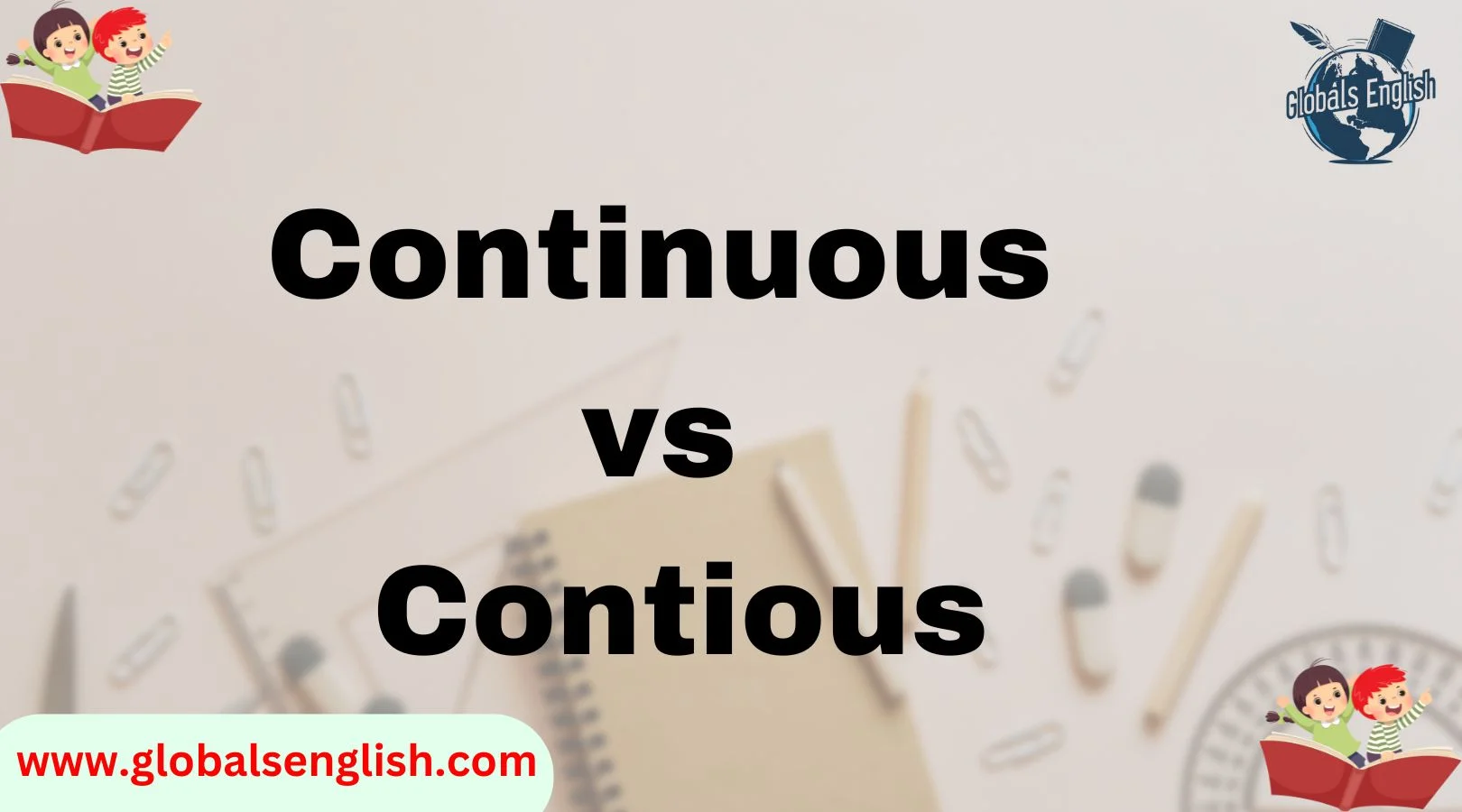Ever been typing fast—maybe shooting out an email, finishing a homework assignment, or drafting a blog—and suddenly you’re staring at a red squiggly line under “contious”? You pause. You double-check. Is it a typo? Or a real word? Or just your autocorrect having a bad day?
If you’ve ever scratched your head over “continuous vs contious,” you’re definitely not alone. These two terms are often confused, and while “continuous” is widely used and accepted, “contious” is a different story altogether.
In this article, we’ll break down what each word means (or doesn’t mean), why one is correct and the other is not, and how you can remember the difference like a pro. This isn’t just a grammar lesson—it’s about getting your communication clear, professional, and error-free. So whether you’re a student, a content creator, or just someone trying to tighten up their language skills, you’re in the right place.
Let’s dive into this surprisingly common spelling mix-up and settle the debate once and for all.
Understanding the Two Words
What Does ‘Continuous’ Mean?
The word “continuous” is an adjective that means uninterrupted, ongoing, or without a break. It describes something that doesn’t stop—a process, a sound, a motion, or even an event.
According to Merriam-Webster, continuous means:
“Marked by uninterrupted extension in space, time, or sequence.”
Let’s look at some example uses:
- The continuous flow of water made the stream sound soothing.
- She maintained continuous eye contact during the interview.
- The factory operates on a continuous schedule, 24/7.
It’s a versatile word used across industries—from science and engineering to business, education, and even music.
Is ‘Contious’ a Real Word?
No, “contious” is not a real word. You won’t find it in the Oxford English Dictionary, Merriam-Webster, or any other reputable dictionary. It’s a misspelling of continuous—a common one, sure, but still incorrect.
Why does it happen so often? A few reasons:
- The pronunciation can trick the ear.
- Spell-check might miss it in certain contexts.
- The brain skips over the missing “u” due to familiarity with similar words like “conscious” or “cautious.”
But just because it “sounds” right doesn’t mean it is right. So if you’re using “contious” in writing, it’s time to retire it permanently.
Correct Spelling: Why ‘Continuous’ Is the Only Accepted Form
Etymology of ‘Continuous’
The word “continuous” has roots in Latin, specifically from continuus, meaning “uninterrupted” or “unbroken.” This, in turn, comes from continere, which means “to hold together.”
Over time, English adopted the Latin word, and it eventually evolved into its modern form with the “u-o-u-s” suffix.
Knowing this origin can help you remember the correct spelling. Think:
- Con = together
- Tinuous = time-related or process-based flow
- Put it together: something held together without a break.
Why ‘Contious’ Might Seem Plausible
Let’s be real—“contious” looks like it could be real, doesn’t it? That’s because it resembles actual English words:
- Conscious
- Cautious
- Precautious
Each of these ends in “-ious,” and that can fool even seasoned writers into thinking “contious” fits the pattern.
But here’s the catch: “continuous” doesn’t follow the “-ious” suffix rule. It ends in -uous, which is a valid and common suffix on its own. Other examples include:
- Virtuous
- Sensuous
- Righteous
The key takeaway? Don’t judge a word’s spelling just by how it sounds or looks.
Usage Examples in Real Sentences
Examples of ‘Continuous’ in a Sentence
Let’s anchor this word into some practical, everyday use cases:
Business:
- “Our company has experienced continuous growth over the past five years.”
Science:
- “Water enters the system in a continuous loop, ensuring no disruption in flow.”
Education:
- “She’s committed to continuous learning, always enrolling in new courses.”
Technology:
- “The platform supports continuous integration to streamline development.”
Personal Life:
- “After hours of continuous rain, the roads started to flood.”
Notice how “continuous” communicates unbroken time, motion, or effort? That’s what makes it such a powerful and descriptive term.
Common Mistakes with ‘Contious’
Here are examples of incorrect usage (and how to fix them):
❌ “The contious noise was irritating.”
✅ “The continuous noise was irritating.”
❌ “She made contious efforts to improve.”
✅ “She made continuous efforts to improve.”
Pro Tip: If your sentence sounds right but looks wrong, it’s probably a spelling issue. Always double-check the word and use a grammar tool if needed.
Grammar and Pronunciation Breakdown
How to Pronounce ‘Continuous’ Correctly
Pronunciation:
- /kənˈtɪn.ju.əs/ (UK & US)
- Break it into syllables: con-tin-u-ous
- Stress is on the second syllable: TIN
Use apps like:
- Google Translate or
- Cambridge Dictionary Audio
These will let you hear the word spoken clearly by native speakers.
Grammatical Role in a Sentence
“Continuous” is an adjective. It describes or modifies a noun. You’ll usually see it:
- Before a noun: “a continuous stream”
- After a linking verb: “the process was continuous”
It doesn’t act as a verb or noun by itself, though it can be part of other grammatical constructions like:
- Continuously (adverb)
- Continuity (noun)
- Continue (verb)
Related Words and Commonly Confused Terms
Continuous vs. Continual: Are They the Same?
Nope. These two are related but not identical.
- Continuous = without interruption
→ “The alarm rang continuously for five minutes.” - Continual = occurring repeatedly but with breaks
→ “We faced continual delays throughout the week.”
Tip:
If it never stops = continuous
If it keeps happening = continual
Continuous vs. Conscious vs. Cautious
Let’s clear up the confusion:
| Word | Meaning | Common Use |
| Continuous | Ongoing, unbroken | Continuous motion |
| Conscious | Aware, awake | She was conscious of danger. |
| Cautious | Careful, avoiding risk | He is cautious when driving. |
Mnemonic:
- Continuous = Time
- Conscious = Self-awareness
- Cautious = Careful
Real-World Context and Relevance
Industries Where ‘Continuous’ Is Frequently Used
- Science & Mathematics: continuous data, continuous variables
- Engineering: continuous process manufacturing
- Software Development: continuous deployment/integration
- Education: continuous assessment, continuous improvement
- Healthcare: continuous monitoring of patients
In each of these areas, accuracy in spelling and usage matters deeply—especially in technical documentation, legal writing, or professional communication.
Why Spelling Accuracy Matters in Professional Communication
Misspelling words like continuous can:
- Damage credibility
- Confuse readers
- Create professional embarrassment
- Reflect poorly on attention to detail
Imagine presenting a report with “contious improvement plan.” It instantly sends the message that something is off—even if your work is otherwise excellent.
How to Remember the Correct Spelling
Spelling Rules and Tips
Try these simple hacks:
- Chunk it: con + tin + u + ous
- Remember: “continuous” contains ‘u-o-u’, not ‘i-o-u’
- Visual trick: Think of a train with no breaks—just cars continuously connected.
Mnemonic Example:
“Connie’s TIN Umbrella Opens Under Storms” = C-O-N-T-I-N-U-O-U-S
It’s silly, but memorable!
Tools to Avoid Spelling Errors
Modern tech can save the day:
- Grammarly – Flags “contious” instantly
- Hemingway App – For clean, error-free writing
- Google Docs – Built-in spell-check
- Microsoft Word – Suggestions for misspelled terms
But remember: Tools help—but knowing the rule is better.
Frequently Asked Questions (FAQs)
Q: Is “contious” ever accepted in casual writing?
A: No, it’s still incorrect—even informally.
Q: Why doesn’t spell-check always catch “contious”?
A: If the word is surrounded by other errors or used in a custom dictionary, it might slip through.
Q: What’s the difference between continuous and nonstop?
A: “Nonstop” is more casual; “continuous” is precise and professional.
Q: Can you say ‘more continuous’?
A: Technically, yes—but “more constant” or “more sustained” may sound better.
Conclusion
Let’s put this to rest: “Continuous” is the correct word. “Contious” is not.
It’s an easy mistake to make but an even easier one to fix. By understanding its meaning, roots, usage, and spelling, you’ve now got the tools to use it with confidence in any context—from emails to essays to executive reports.
Language matters. And mastering the small stuff like this shows that you care about clarity, accuracy, and professionalism.
So next time you’re typing away, and the question pops up again—you’ll know exactly what to write. No red squiggles. No second guesses. Just continuous improvement. 😉

As the visionary founder and CEO of Globals English, Emma Brooke is dedicated to transforming the way individuals learn and master the English language.
